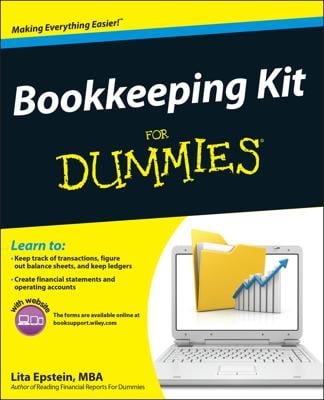Bookkeeping can be made simpler if you follow a logical set of steps. Here are three fundamental concepts that can help keep things in order when handling the books for a business.
Prepare source documents for all transactions, operations, and other business events; source documents are the starting point in the bookkeeping process.
When buying products, a business gets a purchase invoice from the supplier. When borrowing money from the bank, a business signs a promissory note payable, a copy of which the business keeps. When a customer uses a credit card to buy the business’s product, the business gets the credit card slip as evidence of the transaction. When preparing payroll cheques, a business depends on salary rosters and time cards.
All of these key business forms serve as sources of information into the bookkeeping system — in other words, information the bookkeeper uses in recording the financial effects of the business’s activities.
Determine and enter in source documents the financial effects of the transactions and other business events.
Transactions have financial effects that must be recorded — the business is better off, worse off, or at least “different off” as the result of its transactions. Examples of typical business transactions include paying employees, making sales to customers, borrowing money from the bank, and buying products to sell to customers.
The bookkeeping process begins by determining the relevant information about each transaction. The business’s chief accountant establishes the rules and methods for measuring the financial effects of transactions. Of course, the bookkeeper should comply with these rules and methods.
Make original entries of financial effects into journals and accounts, with appropriate references to source documents.
Using the source document(s) for every transaction, the bookkeeper makes the first, or original, entry into a journal and then into the business’s accounts. Only the official, established chart of accounts should be used in recording transactions.
A journal is a chronological record of transactions in the order in which they occur — like a very detailed personal diary. In contrast, an account is a separate record, or page as it were, for each asset, each liability, and so on. One transaction affects two or more accounts. The journal entry records the whole transaction in one place; then each piece is recorded in the two or more accounts that are affected by the transaction.
Entering transaction data correctly and in a timely manner is critically important. The prevalence of data entry errors was one important reason why most retailers started to use cash registers that read barcode information on products, which more accurately captures the necessary information and speeds up the data entry.
Perform end-of-period procedures — the critical steps for getting the accounting records up-to-date and ready for the preparation of management accounting reports, tax returns, and financial statements.
A period is a stretch of time — from one day to one month to one quarter (three months) to one year — that is determined by the business’s needs. A year is the longest period of time that a business would wait to prepare its financial statements. Most businesses need accounting reports and financial statements at the end of each quarter, and many need monthly financial statements.
Compile the adjusted trial balance for the accountant, which is the basis for preparing reports, tax returns, and financial statements.
After all the end-of-period procedures have been completed, the bookkeeper compiles a complete listing of all accounts, which is called the adjusted trial balance. Modest-sized businesses maintain hundreds of accounts for their various assets, liabilities, owners’ equity, revenue, and expenses.
Larger businesses keep thousands of accounts, and very large businesses may keep more than 10,000 accounts. In contrast, external financial statements, tax returns, and internal accounting reports to managers contain a relatively small number of accounts. For example, a typical external balance sheet reports only 25 to 30 accounts (maybe even fewer), and a typical income tax return contains a relatively small number of accounts.
The accountant takes the adjusted trial balance and groups similar accounts into one summary amount that is reported in a financial report or tax return. For example, a business may keep hundreds of separate inventory accounts, every one of which is listed in the adjusted trial balance. The accountant collapses all these accounts into one summary inventory account that is presented in the business’s external balance sheet. In grouping the accounts, the accountant should comply with established financial reporting standards and income tax requirements.
Close the books — bring the bookkeeping for the fiscal year just ended to a close and get things ready to begin the bookkeeping process for the coming fiscal year.
Books is the common term for a business’s complete set of accounts. A business’s transactions are a constant stream of activities that don’t end tidily on the last day of the year, which can make preparing financial statements and tax returns challenging. The business has to draw a clear line of demarcation between activities for the year (the 12-month accounting period) ended and the year yet to come by closing the books for one year and starting with fresh books for the next year.

